The Digital Sensor: A Guide to Understanding Digital Cameras
by Wesley Fink on April 21, 2008 1:00 AM EST- Posted in
- Digital Camera
Bayer vs. Foveon
This title is something of a misstatement, as it would more accurately be Foveon/Sigma versus everyone else in the world. All DSLR imaging sensors except the Foveon use Bayer technology. Digital color images are created by capturing red, blue, and green pixels and then combining them to create a full color image.
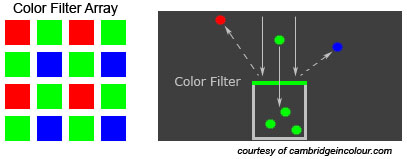
All current sensors except one use Bayer technology. The sensor consists of X megapixels, or light gathering cavities. The sensor is covered with a Bayer array, which is a series of microlenses that allow only certain colors to fall in certain cavities (or pixels). The microlenses are arranged in a defined grid that consists of alternating red-green and green-blue filters.
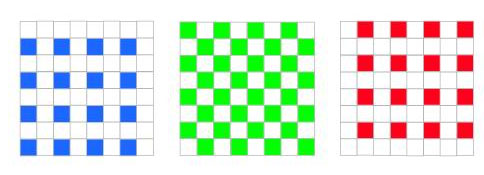
If you noticed there are twice as many green as red or blue areas in the above image, that is by design in the Bayer array. The human eye is more sensitive to green light than red or blue and the Bayer array uses this fact to produce images that appear to have finer detail and less noise. The doubling of the green receptors is corrected in the image processing.
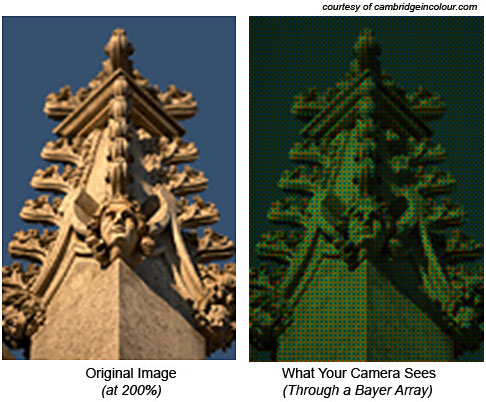
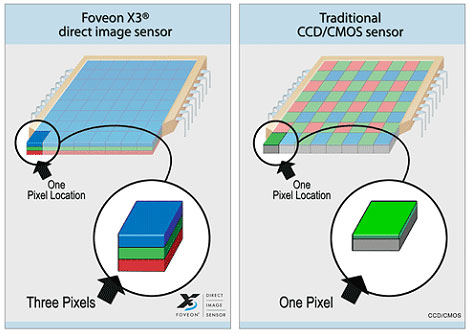
There is no demosaicing or interpolation step with the Foveon sensor. Where before there was one pixel of color information, the Foveon is now capturing red, green, and blue data pixels in the same pixel location. On the surface, this certainly appears a superior way of capturing color images, but things are not always as they appear. It is fair to ask: if this approach is so good then why is Sigma, a minor player in the digital camera market, the only company to embrace the Foveon sensor? A closer look at Foveon specs helps to understand some of the issues.
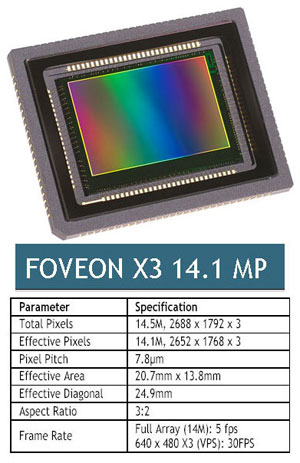
The top current Foveon sensor is the 14.1MP Foveon used in the Sigma SD14 digital camera. Foveon gets to the 14.1MP total by counting all pixels used to create the finished image, which is 2688x1768 pixels or 4.7MP. Many would argue this is fair since each pixel in a competing 14.1MP is only collecting one piece of color information. However, the practical reality is that a 14.1MP Foveon is reported to be about equivalent to an 8MP Bayer DSLR when shooting JPEGs and about as good a 10MP camera when shooting in the preferred and native RAW mode. The apparent resolution then is somewhere between the 4.7MP image size and the 14.1MP that are used to create that image.
Several other issues have also held back Foveon. Where the best Bayer cameras can now capture useful images at ISO 1600, 3200, or even higher, the Foveon sensor is best at lower ISOs. It is usable to about ISO 400 and then noise climbs rapidly as the ISO increases. The latest SD14 Foveon is reported to be better in ISO sensitivity, but it still falls far short of the extended ISO performance of its competition.
The other major issue with the Foveon sensor is that the separation into 3 distinct colors for each pixel site is not nearly as straightforward as Foveon describes it. The captured image still requires a lot of image processing to extract the 3 colors from each pixel site and reconstruct the finished image. In fact some critics claim the image processing required by the Foveon sensor is even more extensive than Bayer Array demosaicing. The purer the data in any extraction process the more faithful it is to the original capture, so the Foveon sensor may offer fewer "post-processing" advantages than it first appears. When conditions and lighting are correct the Foveon can deliver stunning images, but things in photography are rarely perfect.
For the purpose of our discussion the Foveon is more a novelty than a sensor you will likely use today. Despite its limited availability, however, the concept of the Foveon sensor is as compelling as ever, and you can actually buy a production camera, the Sigma SD14, that uses this sensor. As you can see from the specs, the sensor size is 20.7x13.8mm, which places the Foveon between the Canon small APS C and the Olympus 4/3 sensor. The lens multiplier is 1.7X.










72 Comments
View All Comments
teng029 - Tuesday, April 22, 2008 - link
the rebel xti uses a cmos sensor.http://www.usa.canon.com/consumer/controller?act=M...">http://www.usa.canon.com/consumer/contr...&fca...
melgross - Monday, April 21, 2008 - link
Since when did the XTi use a CCD?